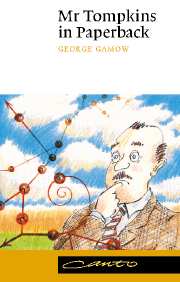Book contents
- Frontmatter
- FOREWORD
- PREFACE
- Contents
- Acknowledgements
- INTRODUCTION
- 1 City Speed Limit
- 2 The Professor's Lecture on Relativity which caused Mr Tompkins's dream
- 3 Mr Tompkins takes a holiday
- 4 The Professor's Lecture on Curved Space, Gravity and the universe
- 5 The Pulsating Universe
- 6 Cosmic Opera
- 7 Quantum Billiards
- 8 Quantum Jungles
- 9 Maxwell's Demon
- 10 The Gay Tribe of Electrons
- 10½ A Part of the Previous Lecture which Mr Tompkins slept through
- 12 Inside the Nucleus
- 13 The Woodcarver
- 14 Holes in Nothing
- 15 Mr Tompkins Tastes a Japanese Meal
10 - The Gay Tribe of Electrons
Published online by Cambridge University Press: 05 June 2013
- Frontmatter
- FOREWORD
- PREFACE
- Contents
- Acknowledgements
- INTRODUCTION
- 1 City Speed Limit
- 2 The Professor's Lecture on Relativity which caused Mr Tompkins's dream
- 3 Mr Tompkins takes a holiday
- 4 The Professor's Lecture on Curved Space, Gravity and the universe
- 5 The Pulsating Universe
- 6 Cosmic Opera
- 7 Quantum Billiards
- 8 Quantum Jungles
- 9 Maxwell's Demon
- 10 The Gay Tribe of Electrons
- 10½ A Part of the Previous Lecture which Mr Tompkins slept through
- 12 Inside the Nucleus
- 13 The Woodcarver
- 14 Holes in Nothing
- 15 Mr Tompkins Tastes a Japanese Meal
Summary
A few days later, while finishing his dinner, Mr Tompkins remembered that it was the night of the professor's lecture on the structure of the atom, which he had promised to attend. But he was so fed up with his father-in-law's interminable expositions that he decided to forget the lecture and spend a comfortable evening at home. However, just as he was getting settled with his book, Maud cut off this avenue of escape by looking at the clock and remarking, gently but firmly, that it was almost time for him to leave. So, half an hour later, he found himself on a hard wooden bench in the university auditorium together with a crowd of eager young students.
‘Ladies and gentlemen,’ began the professor, looking at them gravely over his spectacles, ‘In my last lecture I promised to give you more details concerning the internal structure of the atom, and to explain how the peculiar features of this structure account for its physical and chemical properties. You know, of course, that atoms are no longer considered as elementary indivisible constituent parts of matter, and that this role has passed now to much smaller particles such as electrons, protons, etc.
‘The idea of elementary constituent particles of matter, representing the last possible step in divisibility of material bodies, dates back to the ancient Greek philosopher DEMOCRITUS who lived in the fourth century B.C. Meditating about the hidden nature of things, Democritus came to the problem of the structure of matter and was faced with the question whether or not it can exist in infinitely small portions.
- Type
- Chapter
- Information
- Mr Tompkins in Paperback , pp. 112 - 127Publisher: Cambridge University PressPrint publication year: 1993



